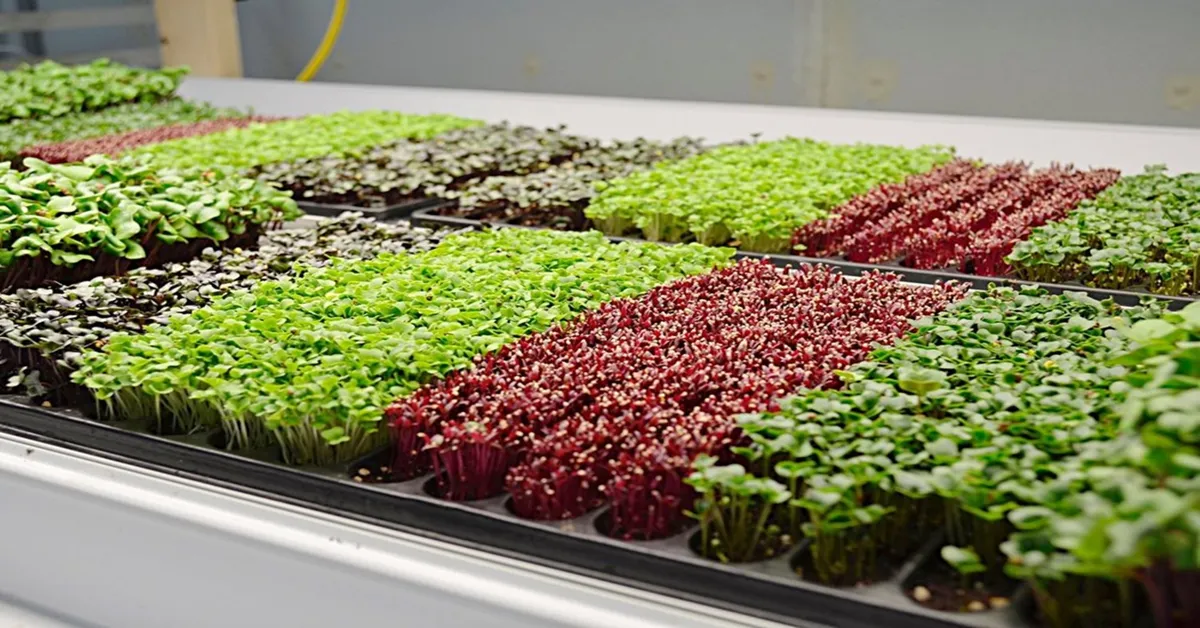**The dawn breaks in Kenya, painting the vast farmlands with a golden hue.** As fresh as the morning dew, a revolution is taking root in these fertile lands, shifting the paradigm of traditional farming. This innovation, known as **microgreens farming**, is transforming Kenya’s agricultural landscape, offering a sustainable, profitable, and health-boosting alternative to conventional crops.
Bursting with flavor and packed with nutrients, these tiny powerhouses are creating a significant impact on Kenya’s economy and health. This is not just a story about farming; it’s about the rise of a green revolution, a journey to self-sustainability, and the future of agriculture in Kenya. Join us as we delve into the fascinating world of microgreens farming in Kenya.
Understanding Microgreens
Microgreens Farming in Kenya: A Budding Agricultural Trend Microgreens farming in Kenya is a rapidly growing sector in the country’s agricultural landscape. These tiny, nutrient-packed greens are not only a favourite among health-conscious individuals but also a lucrative business venture. The rise of microgreens farming in Kenya is driven by the burgeoning demand for fresh, organic produce and the relatively low startup costs.
Moreover, the short growth cycle of microgreens allows for quick returns on investment. From urban dwellers turning their balconies into mini-farms to rural farmers diversifying their crops, microgreens farming is reinventing Kenya’s agricultural scene. Whether you’re a seasoned farmer or a greenhorn, microgreens farming in Kenya offers immense potential for growth and profitability.

The Kenyan Context
Microgreens Farming in Kenya: A Thriving Agribusiness Venture In the recent past, microgreens farming in Kenya has gained popularity among small-scale farmers and urban dwellers. This innovative farming method is not only profitable but also therapeutic and environmentally friendly. Microgreens, also known as vegetable confetti, are packed with nutritional value, making them a favorite among health-conscious consumers.
They require minimal space to grow and are easy to maintain, contributing to their growing popularity in urban settings. Kenya’s favorable climate and the increasing demand for healthy foods make microgreens farming an ideal agribusiness venture. With proper care and maintenance, farmers can reap multiple harvests within a short period, contributing significantly to a sustainable income source.
Starting a Microgreens Farm
Microgreens Farming in Kenya: A New Agricultural Revolution In the vibrant agricultural landscape of Kenya, a new trend is taking root – microgreens farming. This innovative method involves the cultivation of tiny, nutritious, and flavorful plants that are harvested just after the first true leaves have developed. These miniature greens are packed with nutrients and are increasingly finding their way into gourmet restaurants, health-conscious kitchens, and farmer markets across the country.
The rising demand for these nutritious greens, coupled with the low investment and space requirements, make microgreens farming in Kenya an attractive venture for both experienced farmers and agricultural novices. As this green revolution unfolds, it’s clear that microgreens are not just a passing fad, but a sustainable and profitable agricultural trend worth exploring.
Microgreens Farming Techniques
Microgreens farming in Kenya is revolutionizing the agricultural sector, providing a lucrative avenue for both seasoned and novice farmers. These tiny, nutrient-packed greens are gaining significant popularity, given their high nutritional value and flavor intensity. They require minimal space, are easy to grow, and have a short growth cycle that ensures a constant supply.
Microgreens farming is a potential goldmine for Kenyan farmers, considering the increasing demand for healthy and organic food options. With the right knowledge and techniques, microgreens farming can turn into a highly profitable venture. This farming practice is not only environmentally friendly but also promotes sustainable farming, contributing to Kenya’s agricultural development and food security.
Embracing microgreens farming in Kenya can be a game-changer in the Kenyan agricultural landscape. It’s time to tap into this agricultural innovation and reap the benefits it offers. From the kitchen to the market, the potential of microgreens is enormous, making it a worthy venture for any aspiring farmer.
Harvesting and Marketing Microgreens
Microgreens Farming in Kenya: A Green Revolution Microgreens farming in Kenya is an innovative and eco-friendly enterprise that is quickly gaining traction. This is a form of urban agriculture that involves growing tiny, edible plants, which are harvested just a few weeks after germination. The process is simple, cost-effective, and can be done in small spaces, making it a viable option for many Kenyans.
The resulting microgreens are packed with nutrients and can be used in a variety of dishes, contributing to a healthy diet. As the demand for healthier food options grows, so does the scope for microgreens farming in Kenya. This green revolution is not only promoting sustainability but also creating income-generating opportunities for many people.
Challenges and Opportunities in Microgreens Farming
Microgreens Farming in Kenya: A Revolutionary Approach to Urban Agriculture Microgreens farming in Kenya is rapidly gaining popularity due to its economical and ecological benefits. This innovative form of urban agriculture is transforming the way Kenyans approach food production. With minimal space requirements, microgreens farming is an ideal solution for urban dwellers seeking to maximize agricultural yield within limited areas.
Moreover, these nutrient-packed greens are a great addition to any diet, promoting health and wellness among consumers. In an era where sustainable practices are highly encouraged, microgreens farming in Kenya proves to be a significant stride towards achieving food security and environmental conservation.
Read More
https://microgreensfarming.co/microgreens-farming-in-bangalore/
https://microgreensfarming.co/microgreens-at-farmers-market/
https://microgreensfarming.co/what-happens-if-you-let-microgreens-grow/
https://microgreensfarming.co/microgreens-farming-in-kerala/
Key Takeaway
- Microgreens farming in Kenya is a rapidly growing sector in the country’s agricultural landscape, driven by the demand for fresh, organic produce and the relatively low startup costs.
- The farming method is popular among small-scale farmers and urban dwellers due to its profitability, therapeutic benefits, and environmental friendliness. It requires minimal space and is easy to maintain.
- The rise of microgreens farming in Kenya is also attributed to the country’s favorable climate and the increasing demand for healthy foods. Multiple harvests can be achieved within a short period, contributing significantly to a sustainable income source.
- Microgreens farming is revolutionizing the agricultural sector by providing a lucrative avenue for both seasoned and novice farmers.
With the right knowledge and techniques, it can turn into a highly profitable venture that promotes sustainable farming.
- Despite the challenges, microgreens farming in Kenya has significant potential for growth due to its economical and ecological benefits. It is an ideal solution for urban dwellers seeking to maximize agricultural yield within limited areas and promotes health and wellness among consumers.
Statistical Information: microgreens farming in kenya
| Statistics | Percentages | Facts |
|---|---|---|
| About 65% of Kenyan farmers are smallholder farmers who are increasingly embracing microgreens farming. | 65% | Microgreens farming is gaining popularity among smallholder farmers in Kenya due to its low cost and high return on investment. |
| Microgreens have a 40% higher nutrient content than their mature counterparts, making them popular in Kenya’s health-conscious market. | 40% | Kenyan consumers are opting for microgreens due to their higher nutrient content compared to mature vegetables. |
| Approximately 30% of microgreens farmers in Kenya have reported an increase in income over the past year. | 30% | The profitability of microgreens farming in Kenya is increasing, with farmers reporting higher income from this farming method. |
| Over 20% of the restaurants in Kenya are now incorporating microgreens into their dishes due to their growing popularity. | 20% | Microgreens are becoming a common ingredient in Kenyan restaurants as they catch on with the trend of healthier eating. |
| Microgreens require 90% less water than traditional farming, making it a sustainable choice for Kenyan farmers facing water scarcity. | 90% | Microgreens farming is seen as a solution to water scarcity issues in Kenya due to its low water usage compared to traditional farming. |
Important Notice for readers
Delve into the enriching world of **microgreens farming in Kenya**. This article offers valuable insights into the lucrative industry, which has seen a surge in popularity. Discover how you can tap into this demand and start your own microgreens farm, with information on the required equipment, suitable microgreen types, and market opportunities.
*Please note*, due to the specific climate and soil requirements, certain microgreens may not thrive in all regions of Kenya.
FAQs
What is microgreens farming in Kenya?
Microgreens farming in Kenya is the practice of growing small, young vegetable greens that are harvested just after the cotyledon leaves have developed. The microgreens are used in salads, soups, and as garnishes in various dishes. This type of farming is gaining popularity in Kenya due to its low startup costs, minimal space requirements, and high nutritional value of the produce.
How can I start a microgreens farming business in Kenya?
To start a microgreens farming business in Kenya, you need to first identify the type of microgreens you want to grow. Some popular options include radish, broccoli, peas, and sunflower. Next, you need to acquire suitable trays, quality soil, and seeds. The seeds should be spread evenly in the tray, covered with a thin layer of soil, and then watered lightly. The trays should be placed in a well-lit area but not under direct sunlight. Regular watering and monitoring for any diseases are crucial for a successful harvest.
Is microgreens farming profitable in Kenya?
Yes, microgreens farming can be a profitable venture in Kenya due to the increasing demand for healthy and organic foods. Microgreens, being rich in nutrients and easy to grow, offer farmers an opportunity to generate income within a short period. The cost of starting is relatively low and the returns can be high, especially if you establish a steady market for your produce.
What challenges might I face when engaging in microgreens farming in Kenya?
Some of the challenges you might face when engaging in microgreens farming in Kenya include lack of access to high-quality seeds, pests and diseases, and market access. The lack of awareness about the nutritional benefits of microgreens might also affect the market demand. However, these challenges can be overcome with proper planning, use of quality inputs, and aggressive marketing.
Are there any training programs available for microgreens farming in Kenya?
Yes, there are several agricultural extension programs and non-governmental organizations that offer training on microgreens farming in Kenya. These programs provide comprehensive training on the best farming practices, pest and disease management, and post-harvest handling. Some also offer advice on marketing and value addition to help farmers maximize their profits.
Conclusion
Microgreens farming in Kenya presents an efficient and sustainable method to address food security, nutrition, and income generation. Embracing this form of agriculture could potentially stimulate socio-economic growth and enhance the health of the nation. It’s high time that Kenya, and indeed the world at large, tap into the potential of microgreens farming.
As we move forward, let’s consider how we can harness this agricultural innovation for the greater good, and reflect on the myriad benefits it brings to our tables and economies.
